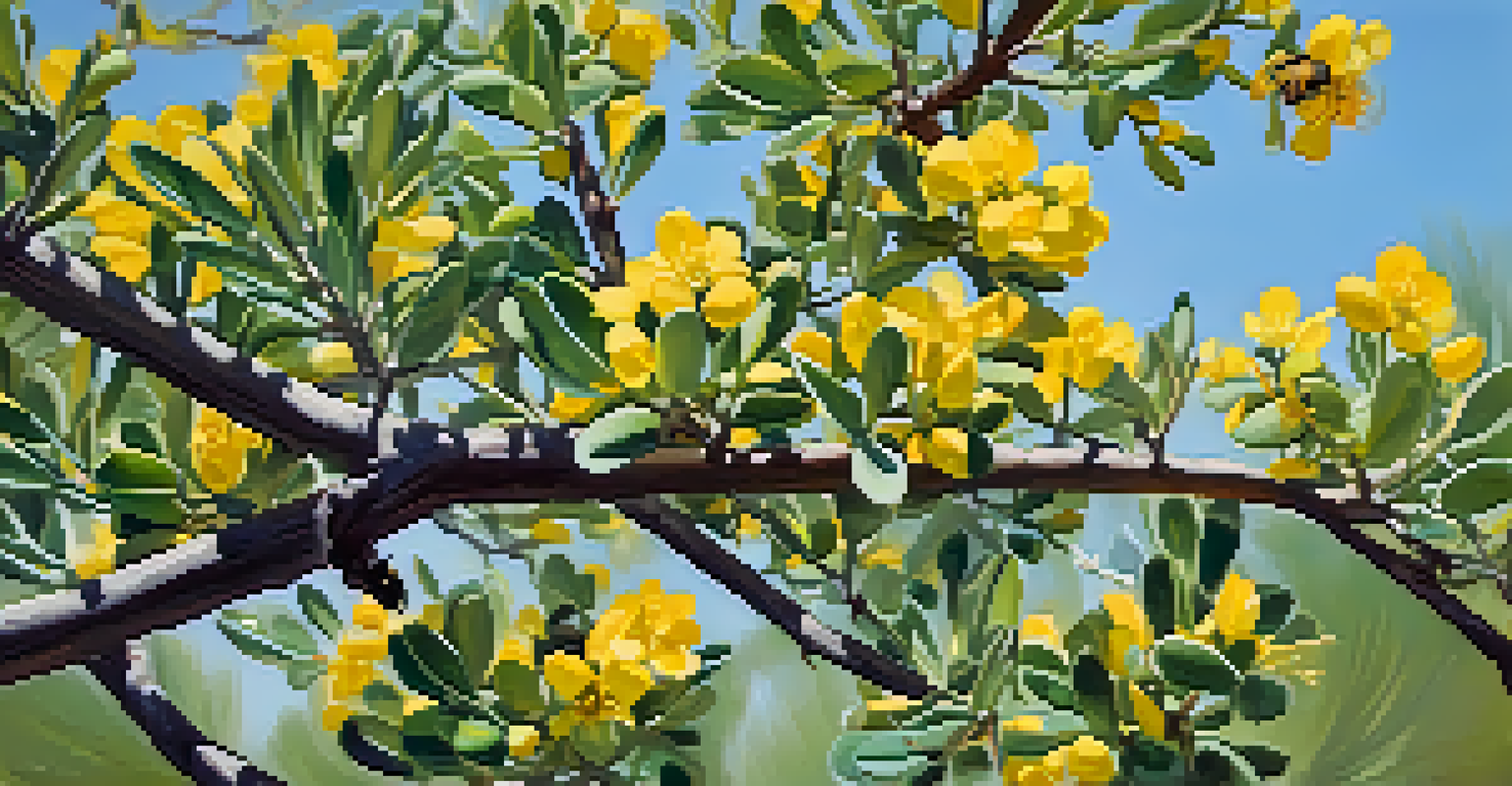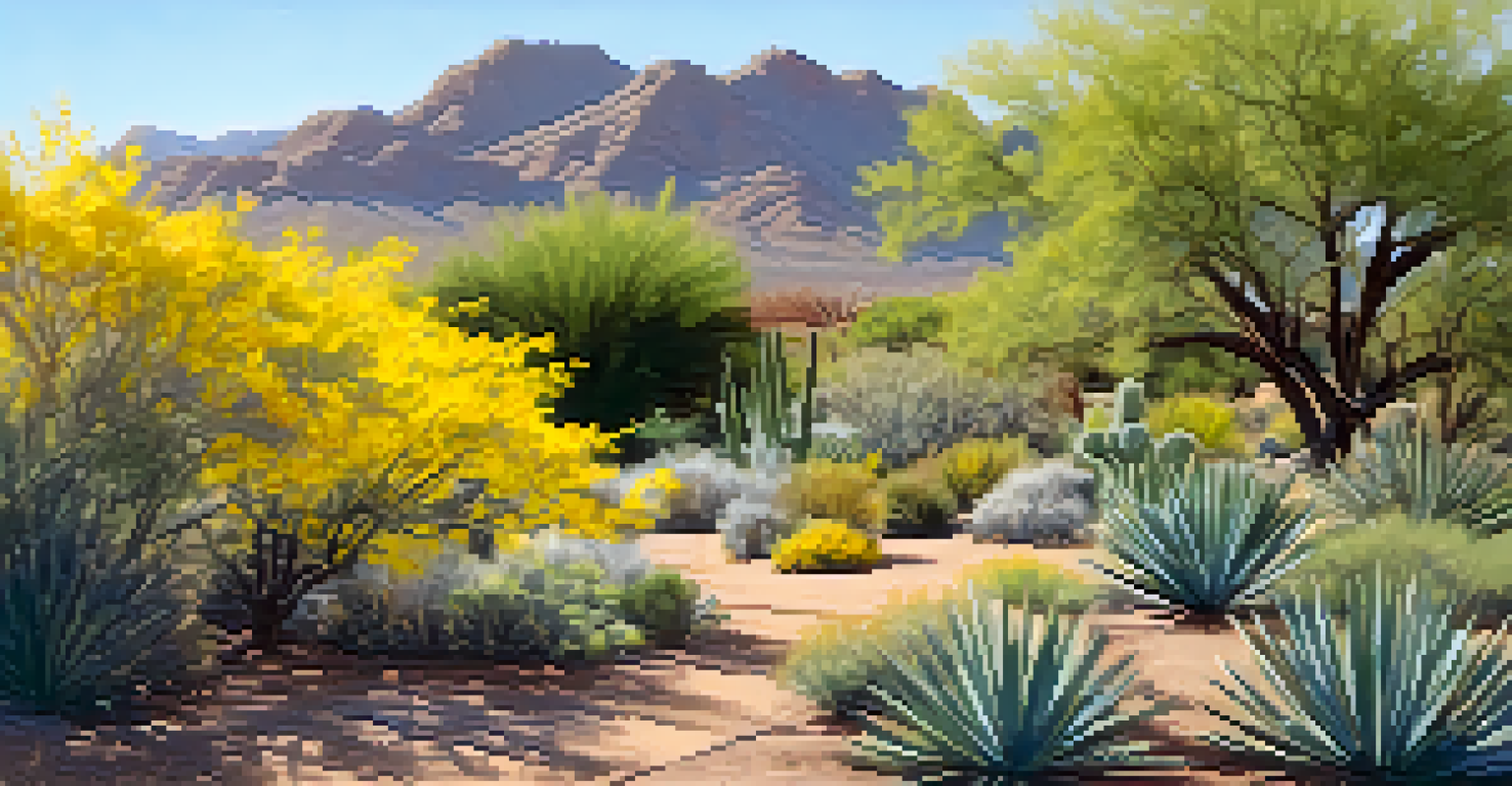Native Plants of Arizona and Their Role in Wildlife Survival

Understanding Native Plants in Arizona's Ecosystem
Native plants are species that have evolved in a specific region over thousands of years. In Arizona, these plants have adapted to the state's unique climate, which ranges from deserts to forests. This adaptation makes them essential for the local ecosystem, as they provide food and shelter for various wildlife.
The greatest threat to our planet is the belief that someone else will save it.
The diverse landscapes of Arizona host a wide array of native plants, including cacti, shrubs, and wildflowers. Each plant plays a vital role in maintaining ecological balance. For example, the Saguaro cactus not only stores water but also serves as a nesting site for birds like the Gila woodpecker.
Understanding the significance of these plants helps us appreciate their role in wildlife survival. By preserving native plants, we also protect the intricate web of life that depends on them, making our ecosystem healthier and more resilient.
The Benefits of Native Plants for Wildlife
Native plants offer numerous benefits to wildlife, acting as a primary source of food for many species. For instance, the flowering plants provide nectar for pollinators, such as bees and butterflies, which are crucial for plant reproduction. Without these native species, many animals would struggle to survive.

In addition to food, native plants also provide essential habitat and shelter. Birds, small mammals, and insects rely on the cover offered by shrubs and grasses to protect themselves from predators. This natural shelter encourages a thriving wildlife population in Arizona.
Native Plants Support Ecosystems
Native plants are crucial for Arizona's ecosystems, providing food and shelter for wildlife while maintaining ecological balance.
Moreover, the presence of native plants helps maintain soil health and prevent erosion. Healthy soil supports a diverse range of organisms, which in turn benefits larger wildlife. By fostering an environment rich in native plants, we create a sustainable habitat for many species.
Top Native Plants and Their Wildlife Connections
Several native plants are particularly crucial for wildlife in Arizona. The Creosote bush, for example, is not only drought-resistant but also provides food for many insects and small animals. Its resilience makes it a staple in the desert ecosystem.
Nature does not hurry, yet everything is accomplished.
Another key player is the Palo Verde tree, known for its vibrant yellow flowers. These flowers attract a variety of pollinators while the tree itself offers shade and nesting opportunities for birds. This interplay between plants and animals showcases nature's intricate connections.
Additionally, the desert marigold is a favorite among butterflies, serving as a nectar source. When we plant and protect these native species, we actively support the wildlife that depends on them. It's a beautiful cycle of life that we can all contribute to.
The Importance of Pollinators in Arizona
Pollinators play a vital role in Arizona's ecosystem, relying heavily on native plants for sustenance. Bees, butterflies, and hummingbirds are among the most significant pollinators, and they help fertilize plants by transferring pollen. This process is essential for the production of fruits and seeds, which are crucial for wildlife survival.
In Arizona, many native plants have evolved to attract specific pollinators. For instance, the red yucca's tubular flowers are perfectly designed for hummingbirds, providing them with nectar. This relationship not only benefits the plants but also ensures the continuation of various animal species.
Pollinators Rely on Native Flora
Pollinators like bees and butterflies depend on native plants for nourishment, which is essential for plant reproduction and wildlife survival.
However, the decline of native plant species due to urban development and climate change poses a threat to these pollinators. By prioritizing native plants in our gardens and landscapes, we can create habitats that support these essential creatures and, in turn, the broader wildlife community.
The Role of Native Plants in Water Conservation
Water conservation is a critical issue in Arizona, where drought conditions are common. Native plants are incredibly efficient in utilizing water resources, making them ideal choices for landscaping. For example, the Arizona sycamore tree has deep roots that tap into underground water supplies, minimizing the need for additional irrigation.
By incorporating native plants into our gardens, we can significantly reduce water usage while still creating beautiful landscapes. These plants are adapted to the local climate, meaning they require less maintenance and are more resilient to dry conditions. This not only benefits the environment but also saves homeowners on water bills.
The relationship between native plants and wildlife is deeply intertwined with water conservation efforts. Healthy native plant populations help retain moisture in the soil, ensuring that wildlife has access to the water they need to thrive. By prioritizing these plants, we contribute to a sustainable future for both nature and humans.
Challenges Facing Native Plants in Arizona
Despite their importance, native plants in Arizona face numerous challenges. Urbanization, invasive species, and climate change threaten their survival. As cities expand, natural habitats are often destroyed, leading to a decline in native plant populations and the wildlife that depends on them.
Invasive species, such as buffelgrass, can outcompete native plants for resources, further endangering them. These non-native plants often spread rapidly and can drastically alter the ecosystem. Efforts to control these invasive species are essential for protecting Arizona's native flora and fauna.
Conservation is Key for Biodiversity
Conservation efforts are vital to protect native plants and the wildlife that relies on them, ensuring a sustainable environment for future generations.
Climate change also poses a significant threat, altering precipitation patterns and temperatures in ways that could make it difficult for native plants to survive. Raising awareness about these challenges is crucial for fostering conservation efforts that protect our native plants and the wildlife they support.
Conservation Efforts for Arizona's Native Plants
Conservation efforts are vital for preserving Arizona's native plants and the wildlife that relies on them. Organizations and community groups actively work to restore habitats and raise awareness about the importance of native flora. These initiatives often include planting native species and removing invasive plants.
Educational programs also play a key role in conservation. Schools and local organizations can teach the community about the benefits of native plants, encouraging residents to incorporate them into their gardens. This grassroots approach fosters a sense of responsibility towards protecting the environment.

By participating in conservation efforts, individuals can make a significant impact. Whether it's volunteering for local restoration projects or simply planting native species in our own yards, every action counts. Together, we can help ensure a thriving ecosystem for future generations.